27037 本科自考英语语言学概论精心整理 Chapter 4 Phonology
【自学考试】江苏省自考英语语言学概论(27037)填空题与选择题题库及中文翻译最新
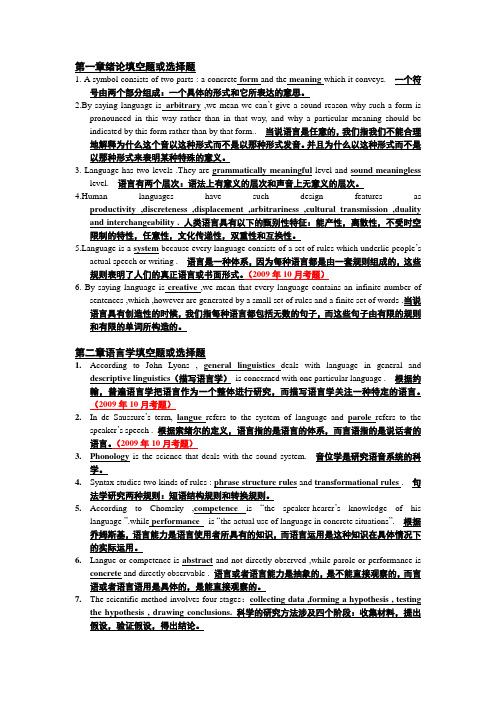
第一章绪论填空题或选择题1. A symbol consists of two parts : a concrete form and the meaning which it conveys.一个符号由两个部分组成:一个具体的形式和它所表达的意思。
2.By saying language is arbitrary ,we mean we can’t give a sound reason why such a form ispronounced in this way rather than in that way, and why a particular meaning should be indicated by this form rather than by that form..当说语言是任意的,我们指我们不能合理地解释为什么这个音以这种形式而不是以那种形式发音。
并且为什么以这种形式而不是以那种形式来表明某种特殊的意义。
3. Language has two levels .They are grammatically meaningful level and sound meaninglesslevel.语言有两个层次:语法上有意义的层次和声音上无意义的层次。
4.Human languages have such design features asproductivity ,discreteness ,displacement ,arbitrariness ,cultural transmission ,duality and interchangeability . 人类语言具有以下的甄别性特征:能产性,离散性,不受时空限制的特性,任意性,文化传递性,双重性和互换性。
nguage is a system because every language consists of a set of rules which underlie people’sactual speech or writing .语言是一种体系,因为每种语言都是由一套规则组成的,这些规则表明了人们的真正语言或书面形式。
自考语言学教程何兆熊

现代语言学笔记Chapter 1: Introduction(1)Chapter 1: Introduction1. Define the following terms:1). Linguistics: It is generally defined as the scientific study of language.2). General linguistics: The study of language as a whole is called general linguistics.3). Applied linguistics: In a narrow sense, applied linguistics refers to the application of linguistic principles and theories to language teaching and learning, especially the teaching of foreign and second languages. In a broad sense, it refers to the application of linguistic findings to the solution of practical problems such as the recovery of speech ability.4). Synchronic study: The study of a language at some point in time. e.g. A study of the features of t he English used in Shakespeare’s time is a synchronic study.5). Diachronic study: The study of a language as it changes through time. A diachronic study of language is a historical study, which studies the historical development of language over a period of time. e.g.a study of the changes English has undergone since Shakespeare’s time is a diachronic study.6). Language competence: The ideal user’s knowledge of the rules of his language. A transformational-generative grammar(转化生成语法)is a model of language competence.7). Language performance: performance is the actual realization of the ideal language user’s knowledge of the rules in linguistic communication.8). Langue : Langue refers to the abstract linguistic system shared by all the members of a speech community; Langue is the set of conventions and rules which language users all have to follow; Langue is relatively stable, it does not change frequently.9). Parole: Parole refers to the realization of langue in actual use; parole is the concrete use of the conventions and the applicationof the rules; parole varies from person to person, and from situation to situation.10). Language: Language is a system of arbitrary vocal symbols used for human communication.11). Arbitrariness: It is one of the design features of language. It means that there is no logical connection between meanings and sounds.A good example is the fact that different sounds are used to refer to the same object in different languages.12). Productivity: Language is productive or creative in that it makes possible the construction and interpretation of new signals by its users.13). Duality: Language is a system, which consists of two sets of structure, or two levels, one of sounds at the lower or basic level, and the other of meanings at the higher level.14). Displacement: language can be used to refer to things which are present or not present, real or imagined matters in the past, present, or future, or in far-away places. In other words, language can be used to refer to contexts removed from the immediate situations of the speaker.15). Cultural transmission: While we are born with the ability to acquire language, the details of any language are not genetically transmitted, but instead have to be taught and learned.16). Design features: It refers to the defining properties of human language that distinguish it from any animal system of communication2. Explain the following definition of linguistics: Linguistics is the scientific study of language.Linguistics investigates not any particular language, but languages in general.Linguistic study is scientific because it is based on the systematic investigation of authentic(可靠的,真实的) language data. No serious linguistic conclusion is reached until after the linguist has done the following three things: observing the way language is actually used, formulating some hypotheses, and testing these hypotheses against linguistic facts to prove their validity.3. What are the branches of linguistics? What does each of them study? (语言学的主要分支是什么。
江苏省自学考试英语语言学概论27037判断题题库及中文翻译

江苏省自学考试《英语语言学概论》(27037)正确判断题题库及中文翻译nguage is primarily speech ,and not the written form.语言主要是口语形式而不是书面形式。
2.The relationship between the sounds and their meanings is arbitrary .声音和他们的意义之间的关系是任意的。
3.Linguistic symbols are produced by human speech organs .语言符号是通过人类语言器官形成的。
4.English linguistics is a kind of descriptive linguistics .英语语言学是一种描述性语言学。
ngue is more abstract than parole and therefore is not directly observable .语言比言语更加抽象,因此是不能直接观察的。
(2009年10月考题)6.General linguistics deals with the whole human language .普遍语言学研究的是所有的人类语言。
7.All the English words are not symbolic .不是所有的英语单词都是有符号的。
8.Descriptive linguistics studies one specific language .描述性语言学研究的是一种具体的语言。
9.The spelling of words is not a reliable means of describing the English sounds .单词的拼写不是描述英语语音的一种可靠方式。
10.In terms of tension of the muscles at pharynx ,vowels are grouped into tense vowels andlax vowels .根据咽喉肌肉的松弛状态,元音可以分成紧元音和松元音。
27037本科自考英语语言学概论精心整理Chapter2Linguistics
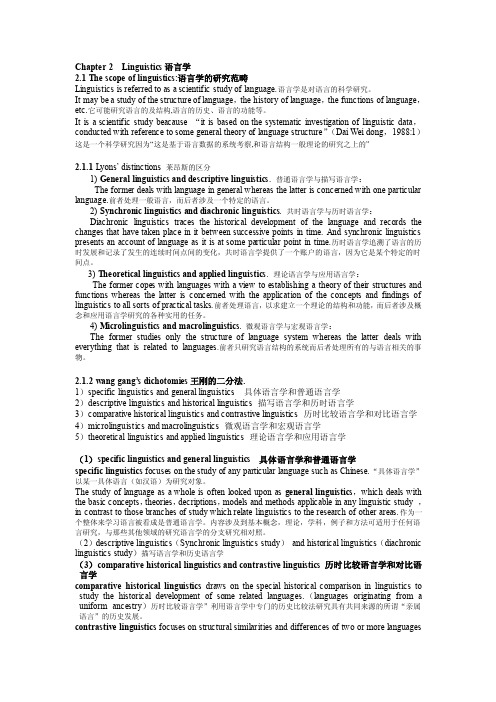
Chapter 2 Linguistics语言学2.1 The scope of linguistics:语言学的研究范畴Linguistics is referred to as a scientific study of language.语言学是对语言的科学研究。
It may be a study of the structure of language,the history of language,the functions of language,etc.它可能研究语言的及结构,语言的历史、语言的功能等。
It is a scientific study beacause “it is based on the systematic investigation of linguistic data,conducted with reference to some general theory of language structure”(Dai Wei dong,1988:1)这是一个科学研究因为“这是基于语言数据的系统考察,和语言结构一般理论的研究之上的”2.1.1 Lyons’ distinctions 莱昂斯的区分1) General linguistics and descriptive linguistics. 普通语言学与描写语言学:The former deals with language in general whereas the latter is concerned with one particular language.前者处理一般语言,而后者涉及一个特定的语言。
2) Synchronic linguistics and diachronic linguistics. 共时语言学与历时语言学:Diachronic linguistics traces the historical development of the language and records the changes that have taken place in it between successive points in time. And synchronic linguistics presents an account of language as it is at some particular point in time.历时语言学追溯了语言的历时发展和记录了发生的连续时间点间的变化,共时语言学提供了一个账户的语言,因为它是某个特定的时间点。
27037本科自考英语语言学概论精心整理chapter4phonology
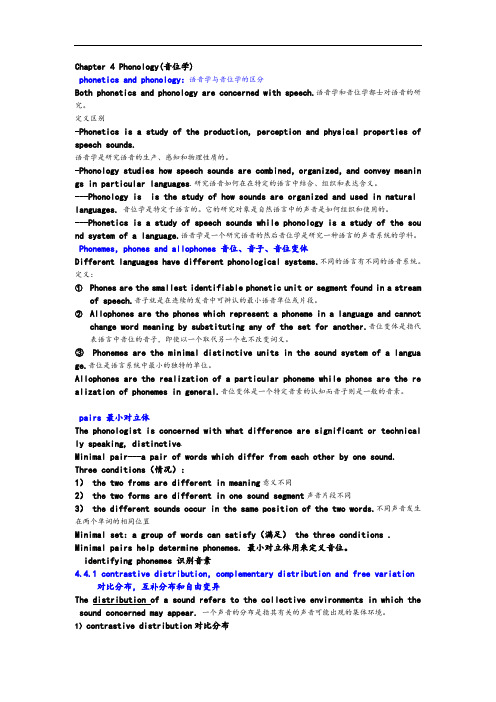
Chapter 4 Phonology(音位学)phonetics and phonology:语音学与音位学的区分Both phonetics and phonology are concerned with speech.语音学和音位学都士对语音的研究。
定义区别-Phonetics is a study of the production, perception and physical properties of speech sounds.语音学是研究语音的生产、感知和物理性质的。
-Phonology studies how speech sounds are combined,organized,and convey meanin gs in particular languages.研究语音如何在在特定的语言中结合、组织和表达含义。
---Phonology is is the study of how sounds are organized and used in natural languages.音位学是特定于语言的。
它的研究对象是自然语言中的声音是如何组织和使用的。
---Phonetics is a study of speech sounds while phonology is a study of the sou nd system of a language.语音学是一个研究语音的然后音位学是研究一种语言的声音系统的学科。
Phonemes,phones and allophones 音位、音子、音位变体Different languages have different phonological systems.不同的语言有不同的语音系统。
定义:①Phones are the smallest identifiable phonetic unit or segment found in a streamof speech.音子就是在连续的发音中可辨认的最小语音单位或片段。
27037 本科自考英语语言学概论精心整理 Chapter 6 Syntax(word文档良心出品)

Chapter 6 Syntax 句法学6.1 Syntax:definition 定义Syntax is a study of sentences:sentence structure and formation 句法学就是对句子的学习。
Syntax can be defined as the branch of linguistics that studies how the words of a lang uage can be combined to make larger units, such as phrases, clauses and sentences.语法可以被定义为语言学的分支研究语言的词汇如何被合并成更大的单位,比如短语和句子,从句。
It studies the interrelationships between elements of the sentence structure and the rul es governing the production of sentences.它研究句子中各种成分之间的关系。
句法研究语言的句子结构。
Finite(有限的)number of words and small set of rules can create infinite number of sentences.有限的单词和少量规则能创造无穷尽的句子。
Syntactic knowledge: the intuition of a native speaker about how words are combined to be phrases and and how phrases are combined into sentences.句法知识:说话者用直觉知道母语词汇如何结合成词组和短语如何组合成的句子。
6.2 Grammar,syntax and morphology 语法、句法学和形态学Grammar :“the knowledge and study of the morphological and syntactic regularities of a natural language. ”It excludes phonetics, phonology, semantics.语法是关于自然语言形态规则和句法规则的知识和研究。
chapter 4 phonology
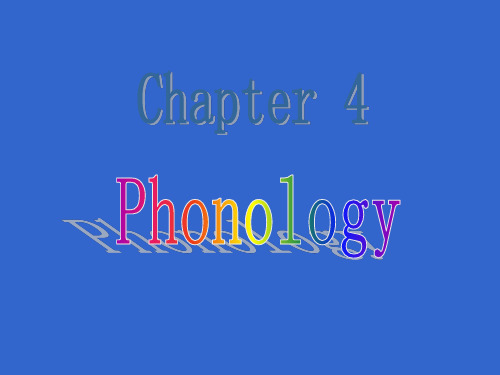
Rule 3: deletion rule(省略规则) A sound is to be deleted although it is orthographically represented. eg.(1) signature, designation, paradigmatic • (2) sign, design, paradigm deleted • In the second group, /g/ is _______.
• 音位有时还可能有free variants
互补分布
当同一个音位的两个或两个以上的音位变体 不区别意义,并且永远不会出现在相同的位 置上,那么它们被称为处于互补分布。 [p]/[pʰ]是两个不同的音子,即音位/p/的变化 形式。[p]只出现在[s]之后,而[pʰ]只出现在其 他位置。 /p/→[p]/[s]͟ [pʰ]剩余位置 注:——是/p/出现的位置
phonetics and phonology
Phonetics General (concerned with speech sounds as such without reference to their function in a particular language). Descriptive Classificatory Particular (having a particular language or languages in view) Functional (concerned with the working or functioning of speech sounds in a language or languages) Functional phonetics p137
自由变体
《英语语言学概论》重、难点提示_百度文库
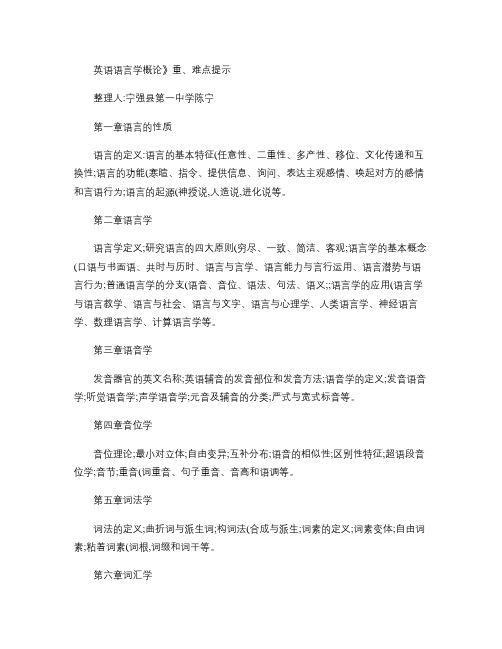
英语语言学概论》重、难点提示整理人:宁强县第一中学陈宁第一章语言的性质语言的定义:语言的基本特征(任意性、二重性、多产性、移位、文化传递和互换性;语言的功能(寒暄、指令、提供信息、询问、表达主观感情、唤起对方的感情和言语行为;语言的起源(神授说,人造说,进化说等。
第二章语言学语言学定义;研究语言的四大原则(穷尽、一致、简洁、客观;语言学的基本概念(口语与书面语、共时与历时、语言与言学、语言能力与言行运用、语言潜势与语言行为;普通语言学的分支(语音、音位、语法、句法、语义;;语言学的应用(语言学与语言教学、语言与社会、语言与文字、语言与心理学、人类语言学、神经语言学、数理语言学、计算语言学等。
第三章语音学发音器官的英文名称;英语辅音的发音部位和发音方法;语音学的定义;发音语音学;听觉语音学;声学语音学;元音及辅音的分类;严式与宽式标音等。
第四章音位学音位理论;最小对立体;自由变异;互补分布;语音的相似性;区别性特征;超语段音位学;音节;重音(词重音、句子重音、音高和语调等。
第五章词法学词法的定义;曲折词与派生词;构词法(合成与派生;词素的定义;词素变体;自由词素;粘着词素(词根,词缀和词干等。
第六章词汇学词的定义;语法词与词汇词;变词与不变词;封闭词与开放词;词的辨认;习语与搭配。
第七章句法句法的定义;句法关系;结构;成分;直接成分分析法;并列结构与从属结构;句子成分;范畴(性,数,格;一致;短语,从句,句子扩展等。
第八章语义学语义的定义;语义的有关理论;意义种类(传统、功能、语用;里奇的语义分类;词汇意义关系(同义、反义、下义;句子语义关系。
第九章语言变化语言的发展变化(词汇变化、语音书写文字、语法变化、语义变化;第十章语言、思维与文化语言与文化的定义;萨丕尔-沃夫假说;语言与思维的关系;语言与文化的关系;中西文化的异同。
第十一章语用学语用学的定义;语义学与语用学的区别;语境与意义;言语行为理论(言内行为、言外行为和言后行为;合作原则。
- 1、下载文档前请自行甄别文档内容的完整性,平台不提供额外的编辑、内容补充、找答案等附加服务。
- 2、"仅部分预览"的文档,不可在线预览部分如存在完整性等问题,可反馈申请退款(可完整预览的文档不适用该条件!)。
- 3、如文档侵犯您的权益,请联系客服反馈,我们会尽快为您处理(人工客服工作时间:9:00-18:30)。
Chapter 4 Phonology(音位学)phonetics and phonology:语音学与音位学的区分Both phonetics and phonology are concerned with speech.语音学和音位学都士对语音的研究。
定义区别-Phonetics is a study of the production, perception and physical properties of speech sounds.语音学是研究语音的生产、感知和物理性质的。
-Phonology studies how speech sounds are combined,organized,and convey meanings in particular languages.研究语音如何在在特定的语言中结合、组织和表达含义。
---Phonology is is the study of how sounds are organized and used in natural languages.音位学是特定于语言的。
它的研究对象是自然语言中的声音是如何组织和使用的。
---Phonetics is a study of speech sounds while phonology is a study of the sound system of a language.语音学是一个研究语音的然后音位学是研究一种语言的声音系统的学科。
Phonemes,phones and allophones 音位、音子、音位变体Different languages have different phonological systems.不同的语言有不同的语音系统。
定义:Phones are the smallest identifiable phonetic unit or segment found in a stream of speech.音子就是在连续的发音中可辨认的最小语音单位或片段。
Allophones are the phones which represent a phoneme in a language and cannot change word meaning by substituting any of the set for another.音位变体是指代表语言中音位的音子,即使以一个取代另一个也不改变词义。
③Phonemes are the minimal distinctive units in the sound system of a language.音位是语言系统中最小的独特的单位。
Allophones are the realization of a particular phoneme while phones are the realization of phonemes in general.音位变体是一个特定音素的认知而音子则是一般的音素。
pairs 最小对立体The phonologist is concerned with what difference are significant or technically speaking, distinctive.Minimal pair---a pair of words which differ from each other by one sound.Three conditions(情况):1)the two froms are different in meaning意义不同2)the two forms are different in one sound segment声音片段不同3)the different sounds occur in the same position of the two words.不同声音发生在两个单词的相同位置Minimal set: a group of words can satisfy(满足)the three conditions . Minimal pairs help determine phonemes. 最小对立体用来定义音位。
identifying phonemes 识别音素4.4.1 contrastive distribution,complementary distribution and free variation对比分布,互补分布和自由变异The distribution of a sound refers to the collective environments in which the sound concerned may appear.一个声音的分布是指其有关的声音可能出现的集体环境。
1)contrastive distribution对比分布If two or more sounds can occur in the same environment and the substitution of one sound for another brings about a change of meaning,they are said to be in contrastive distribution.如果两个或更多的声音可以发生在相同的环境并且一旦一个声音替换另一个会改变的意思,那他们就是处于对比分布。
2)complementary distribution互补分布If two or more sounds never appear in the same environment,that is,each sound only appears in the environments where the other sound never occurs,then they are said to be in complementary distribution.如果两个或更多的声音从未出现在相同的环境中,也就是每一个声音只出现在其他的声音不出现的环境中,然后他们被称为处在互补分布。
3)free variation 自由变异When two sounds can appear in the same environment and the substitution of one for the other does not cause any change in meaning,they are said to be in free variation.当两个声音可以出现在相同环境但是替换一个其他不会导致任何意思的改变, 然后他们被称为处在自由变异。
4.4.2 Principles of identifying phonemes 识别音位的四个原则(1)If two sounds are found to be in contrastive distribution,they are separate phonemes. 如果两个音处于对比分布,那么它们是两个独立的音位。
(2)If two sounds are always in free variation, then they are two allophones of the same phoneme. 如果两个音总是处于自由变异,则这两个音是同一个音位的音位变体。
(3)If two phonetically similar sounds are in complementary distribution, then they are two allophones of the same phoneme.如果语音上相似的两个音处于互补分布,则它们是同一个音位的音位变体。
(4)If two sounds are in complementary distribution but have no phonetic similarity, then they are two different phonemes.如果两个音处于”互补分布”,但没有语音相似性,他们肯定是两个不同的音位。
Procedures:过程1 check principle (1) and find minimal pairs. If yes, then two sounds are phonemes.2 If no minimal pair is found, check principle(2). The answer is always NO, direct3 Check principle (3). if yes, phonemes. If no, come to principle 44 Check principle (4), if yes, phonemesDistinctive features 区别性特征定义:A distinctive feature is one which distinguishes one phoneme from another,区别性特征就是把两个音位相互区分的特征like /nasal/,/voiced/.Phonetic features are used to describe allophones, or phones.The distinctive feature theory is put forward by Jakobson.Phonological rules 音位规则4.6.1 Assimilation rule 同化规则定义:An assimilation rule is a phonological rule that is to describe the effect of phonetic context or situation on a particular phone.同化规则是描述一个特定音子下语音上下文和情形效果的一个语音规则。
It assimilates one segment to another by“copying”a feature of a sequential phoneme to another, thus making the two phones more similar.它通过“模仿”一个序列音位的一个特征使一个语音与另一个语音相似,从而使两个音子变得相似。
4.6.2 Deletion rule 省略规则定义:The deletion rule in phonology concerns the relation between letters and sounds within the phonetic condition.在音位学中省略规则是关于在语音条件下字母与声音的关系。
